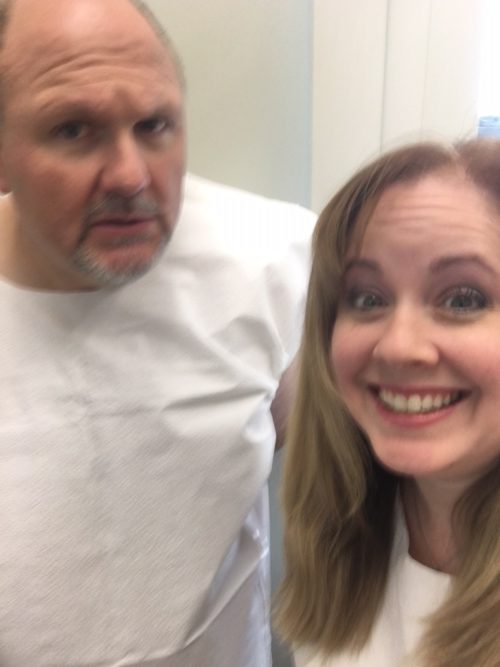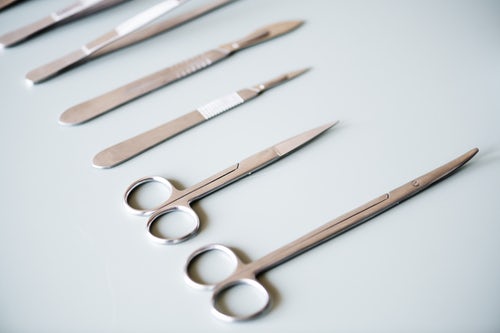
It was raining hard on a Thursday afternoon when we stepped into the dermatologist office. I shook off our umbrella and left it by the front door next to a dry one that must have been forgotten. As my husband took my raincoat, I walked towards the reception desk to check in for our couple’s appointment. There were three others in the waiting room: a couple reading the television’s closed captioning for an episode of HGTV and a single woman scrolling through her phone. After signing us in, I sat next to my husband and smiled an exaggerated, animated grin, “Are you ready for this?” He rolled his eyes and looked back at an email on his phone, “No.”
EXAM ROOM ONE
“Daniel and Eleanor?”
We were moved from the lobby into a room with a sign that read EXAM ROOM ONE. I don’t believe it could’ve been an actual exam room unless you were taking a written test. The room was small, had two chairs and a metal podium to place notes or a laptop. The nurse closed the door behind us and began asking a series of questions to each of us one at a time: “Do you have any allergies? A history of skin cancer in your family? Have you ever used a tanning bed? Do you wear sunscreen? What level SPF? Do you work outside? What brings you to the office today? Do you have any specific concerns or problem areas?” The nurse took our temperature and noted our weight on a digital scale.

UNDRESSING – It’s required
After the nurse’s questions had been satisfactorily answered, we were escorted to a larger room with no number on the door. It had an exam table, a rolling stool, a doctor’s desk, computer equipment, sterilized tools and two metal frame chairs. She handed a crinkly, white folded piece of paper about the size of a small tablecloth to both of us. She said, “Leave undergarments on — your underwear, bra — and take everything else off and then put on this gown. Oh, and…” the nurse looked at us over her shoulder while holding the door open, “the gown opens in the back.”
When the door closed, I confessed with a giggle, “I’m always so relieved when they tell which way to wear it.” I started kicking off my shoes and unbuttoning my shirt. I looked over at my husband who hadn’t moved.
“What are you doing?” I said, “Why aren’t you getting undressed?”
“I’m not doing that,” he nodded at his folded paper which he tossed on the exam table.
I laughed and resumed undressing. “OHHH yes, you are. This is ALL YOU big guy. You’re the one who said that we should do this and that so many of our friends were having moles removed and coming to work wearing band-aids.” He shook his head. I slid off my pants, folded and placed them on one of the chairs.
“How can a skin doctor examine your skin if you’re wearing a shirt and tie?” His face revealed shock and indignation as he watched me prepare for the exam. “Let’s just go. I’m not doing this.”
I slid on the robe (which, by the way, I could not manage to fasten with the little plastic strap) so I held it closed with one hand like a chip clip. I straightened my posture in an act of defiance and to stave off my embarrassment. I raised my eyebrows and without a word, he began tugging on his tie.

MEET THE DERMATOLOGIST
The doctor knocked on the numberless door, introduced herself and immediately congratulated us for being wise enough to set the baseline for years of future appointments so we could document any noticeable skin changes. When you come to a dermatologist appointment as a couple (especially the first time) she added, the moral support can make you feel more at ease and as you’ll see, it’s beneficial to look out for one another.
The doctor visually scanned each of us, lightly touching our skin with her hand as she focused on a specific region of our body. She looked in between our toes, around our ankles, calves, knee, thighs, stomach, back, and continued with neck, shoulders, arms, face, and scalp. Examination of my husband’s scalp was not as intrusive as mine considering I have mountains of hair. The doctor periodically called out medical terminology to a responsive, but quiet attendant taking dictation and recording notes into a laptop.
NOTES FROM HIS EXAM:
Male Patient has Type II skin
Left upper eyelid with small skin colored pedunculated papule
Left dorsal forearm with tan keratotic papule on the erythematous base
Numerous regular tan-brown macules of sun-exposed areas of skin
Recommended Procedure:
Destruction of the benign lesion after verbal consent with liquid nitrogen cryotherapy on left dorsal forearm and removal of Skin Tag — Left upper eyelid. No anesthesia – sharp scissor excision.

NOTES FROM MY EXAM
Female Patient has Type II skin
Right posterior lower leg with tan verrucous papule on the erythematous base
Regular tan-brown macules of sun-exposed areas
Thin brown papules with regular borders and pigmentation
Recommended Procedure:
Destruction of the benign lesion after verbal consent with liquid nitrogen cryotherapy on right posterior lower leg
IN LAYMAN’S TERMS
In non-medical terms, this means that my husband and I have light skin, but we are not the fairest of them all, which would be Type 1 Skin. He has a skin tag (extra skin growth protruding on the top left eyelid) and a mole-like growth on his left arm. The tan-brown macules are freckles from the Latin macula, which means spot. I have bunches of freckles and only one mole-like growth but nothing on us was pre-cancerous.
DERMATOLOGIST SAME-DAY PROCEDURES
The tan verrucous papule on the erythematous base (growth on the back of my leg) was unsightly rather than a health risk, but I agreed to have it removed. I did have mild trepidation about the procedure and I expressed my concerns since I’ve never had anything frozen off of me. The dermatologist explained that she would use Cryotherapy* (“freeze it off”) by using a concentrated spray directly on the area. To demonstrate, she took my hand and blew cold air out of a container that looked similar to the compressed air you’d use to blow off the dust from a keyboard. She explained that the nozzle would “zero in” on the spot and freeze it off. The procedure stung but it wasn’t awful.
*Cryotherapy is performed to remove growths from the skin by causing superficial “frostbite.” It may take 2-10 days for the lesion to fall off and complete healing may take up to two weeks.
The pedunculated papule, (skin tag) on my husband’s eyelid was removed by the snip of a sterile pair of scissors. I couldn’t watch the snipping of anything near his eyes but Danny said it wasn’t bad and his eye looked immediately better. In just a few minutes, there was nothing more than a red dot on his eyelid which faded before she moved onto his arm. All of the lesions were removed that day which was convenient and the entire appointment was a little less than an hour. There was no need to set other appointments for the procedures. No coming back on another day. We just had it done while we were already there! Easy peasy.
COUPLE’S DERMATOLOGIST APPOINTMENTS FOR THE WIN
Couple’s dermatologist appointments are great because you each have moral support and can hold the other accountable if they want to chicken out of the visit. (Bawk-bawk, Danny.) Most procedures can be performed in the office during the appointment so no need to schedule another day to come in. Making a tandem appointment with a spouse is also helpful because the doctor can point out places to watch on the other in hard to see places like the back, neck, and top of the head.
It’s also important for your overall health, to care for your skin since it’s the body’s largest organ. It serves as a protective barrier between your insides and your environment. Skin helps regulate body temperature and acts as a filter. Skin is in a constant state of growth and annual check-ups are suggested. I would definitely recommend a couple’s doctor appointment especially if your significant other is your best friend and you need a good laugh — or if they have any hesitation of going to a type of doctor they’ve never experienced.





















